Here in this post, we will help you understand Enable Windows NTP Client Using Intune. We are going to use Configuration Profiles of Intune to implement this policy. Our main purpose here is to help you acquire knowledge of how to Enable Windows NTP Client Policy Using Intune.
Enable Windows NTP Client Policy Using Intune policy determines the status of the Windows NTP Client. Enabling the Windows NTP Client permits your computer to synchronize its system clock with external NTP servers. You may choose to deactivate this feature if you prefer to employ a third-party time provider.
Enabling this policy allows you to configure the local computer clock to synchronize time with NTP servers. Conversely, if you disable or leave this policy configured, the local computer clock will not synchronize with NTP servers.
Organizations or individuals may prefer to use third-party time providers or hardware-based time synchronization solutions in some situations. If you decide to go this route, you can disable the Windows NTP Client to prevent it from trying to synchronize with NTP servers. This allows you to rely entirely on your chosen time provider.
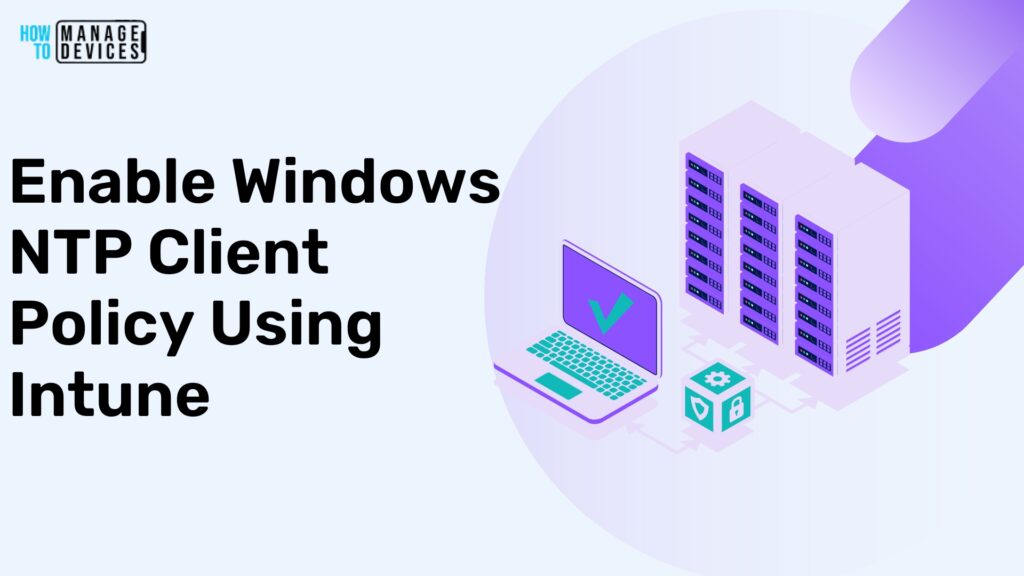
- Turn Off the Picture Password Sign-In Policy using Intune
- Don’t Enumerate Connected Users on Domain-joined Computers Policy using Intune
Windows CSP Details W32TIME_POLICY_ENABLE_NTPCLIENT
We will see Windows CSP Details for this Policy setting W32TIME_POLICY_ENABLE_NTPCLIENT. The Windows NTP Client policy allows administrators to control how their Windows systems handle time synchronization.
Enabling it ensures accurate timekeeping by synchronizing with NTP servers while disabling it or leaving it unconfigured means relying on other timekeeping methods or third-party time providers. Proper time synchronization is crucial for various aspects of system functionality, security, and auditing, so understanding and configuring this policy appropriately is important in many IT environments.
CSP URI – ./Device/Vendor/MSFT/Policy/Config/ADMX_W32Time/W32TIME_POLICY_ENABLE_NTPCLIENT

Enable Windows NTP Client Using Intune Settings Catalog
To set the Enable Windows NTP Client Policy Using Intune, follow the steps stated below:
- Sign in to the Intune Admin Center portal https://intune.microsoft.com/.
- Select Devices > Windows > Configuration profiles > Create a profile.
In Create Profile, I select Windows 10 and later in Platform and select Profile Type as Settings catalog. Click on Create button.
| Platform | Profile Type |
|---|---|
| Windows 10 and later | Settings Catalog |
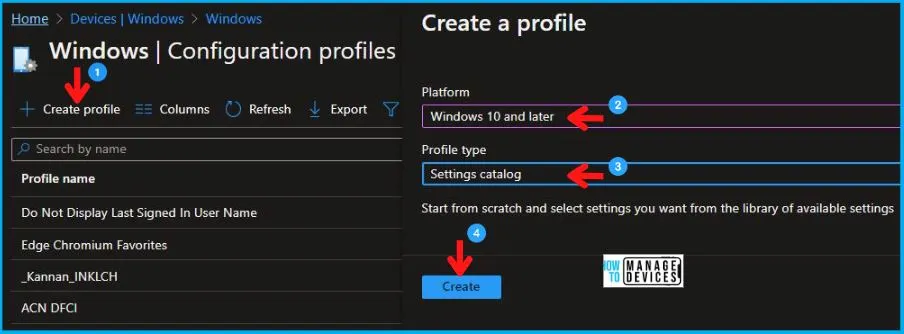
On the Basics tab pane, I provide a name for the policy as “Enable Windows NTP Client Policy.” Optionally, if you want, you can enter a policy description and proceed by selecting “Next.”
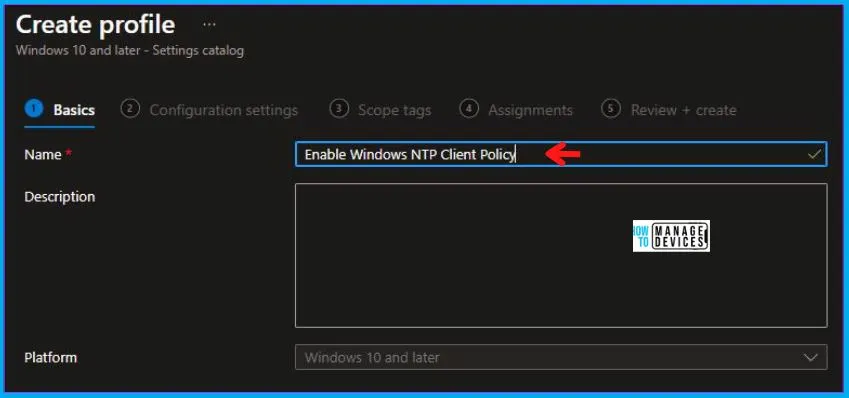
Now in Configuration Settings, click Add Settings to browse or search the catalog for the settings I want to configure.
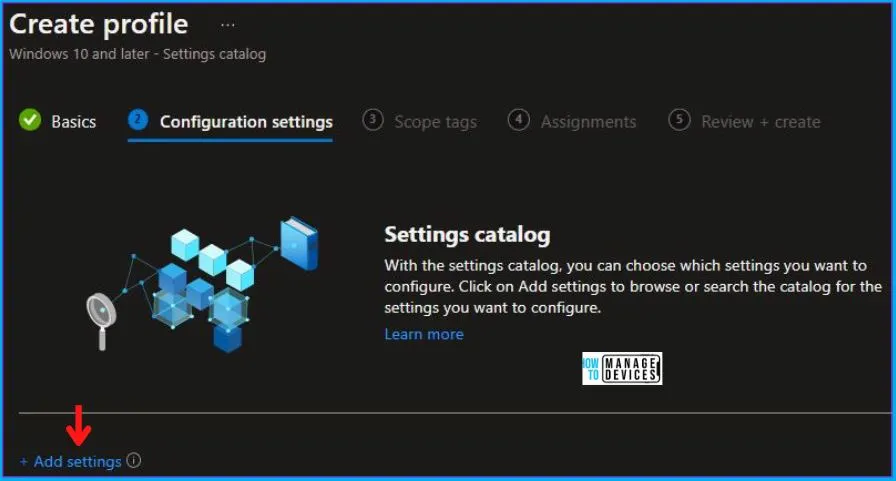
In the Settings Picker windows, I searched for the keyword NTP, I found the category Administrative Templates\System\Windows Time Service\Time Providers and selected this.
When I select that option as stated above, I see the sub-category, Enable Windows NTP Client. After selecting that, click the cross mark at the right-hand corner, as shown below.
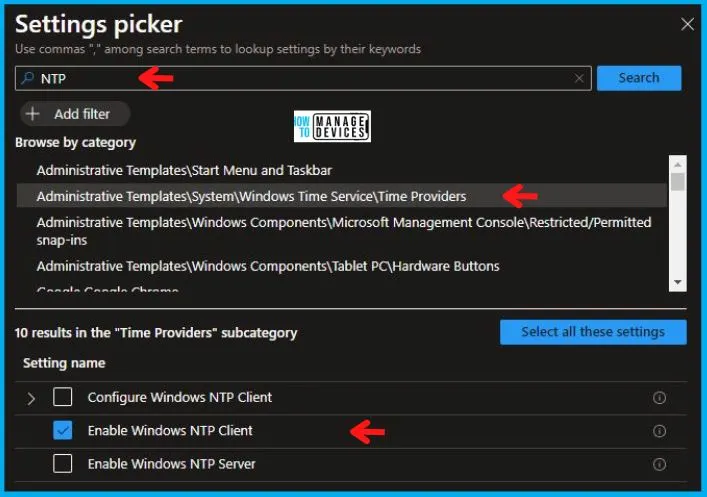
I kept the Enable Windows NTP Client as Enabled in the Administrative Templates and clicked on Next to continue.
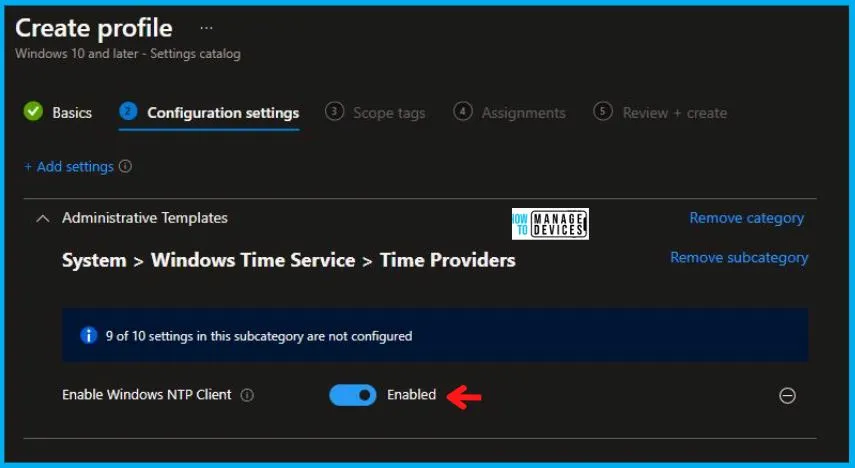
Using Scope tags, you can assign a tag to filter the profile to specific IT groups. One can add scope tags (if required) and click Next to continue. Now in Assignments, in Included Groups, you need to click on Add Groups, choose Select Groups to include one or more groups, and click Next to continue.
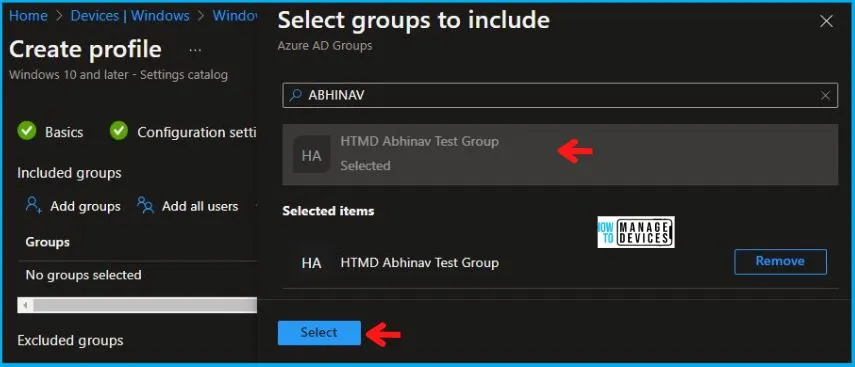
In the Review + Create tab, I review settings. After clicking on Create, changes are saved, and the profile is assigned.
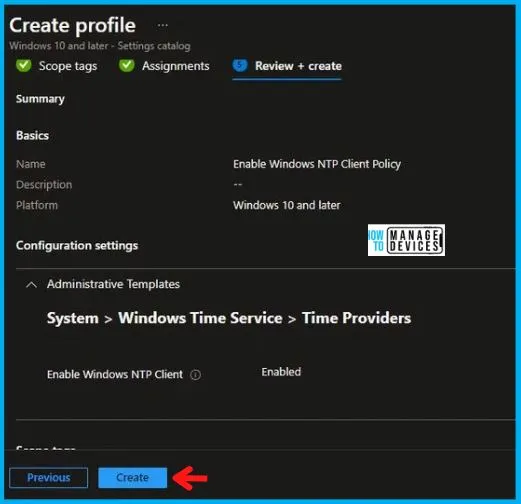
Upon successfully creating the “Enable Windows NTP Client Policy,“ notification will appear in the top right-hand corner, confirming the action. You can also verify the policy’s existence by navigating to the Configuration Profiles list, where it will be prominently displayed.
Your groups will receive your profile settings when the devices check in with the Intune service. The Policy applies to the device.
Intune Report for Enable Windows NTP Client Policy
From Intune Portal, you can view the Intune settings catalog profile report, which provides an overview of device configuration policies and deployment status.
To track the assignment of the policy, you need to select the relevant policy from the Configuration Profiles list. Reviewing the device and user check-in status lets you determine if the policy has been successfully applied. If you require more detailed information, you can click on “View Report” to access additional insights.
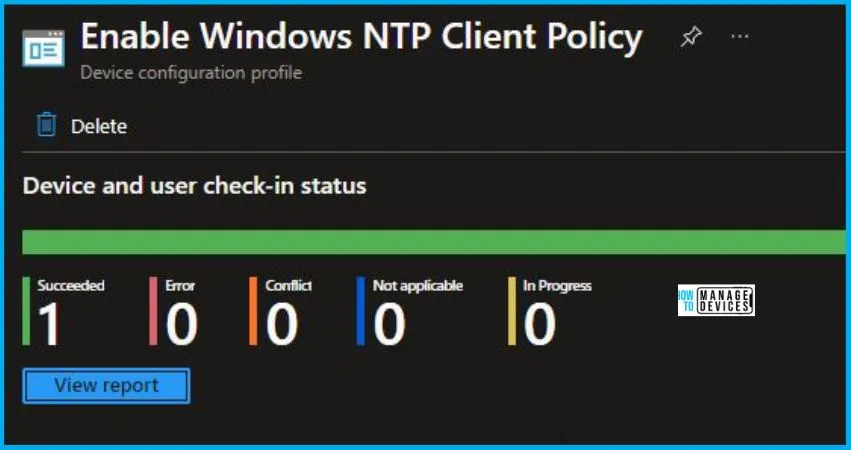
Intune MDM Event Log
To verify the successful implementation of String or integer policies on Windows 10 or 11 devices through Intune, you can leverage event IDs 813 and 814. These event IDs provide valuable insights into the application status of the policy as well as the specific value assigned to the policy on those devices. In the case of this particular policy, the value is String and is linked to the event ID 814.
By analyzing these event IDs, you can gain a clear understanding of the policy’s application status and the corresponding value associated with it on the devices in question.
To confirm this, you can check the Event log path – Applications and Services Logs – Microsoft – Windows – Devicemanagement-Enterprise-Diagnostics-Provider – Admin.
MDM PolicyManager: Set policy string, Policy: (W32TIME_POLICY_ENABLE_NTPCLIENT), Area: (ADMX_W32Time), EnrollmentID requesting merge: (5B88AEF1-09E8-43BB-B144-7254ACBBDF3E), Current User: (Device), String: (<enabled/>), Enrollment Type: (0x6), Scope: (0x0).
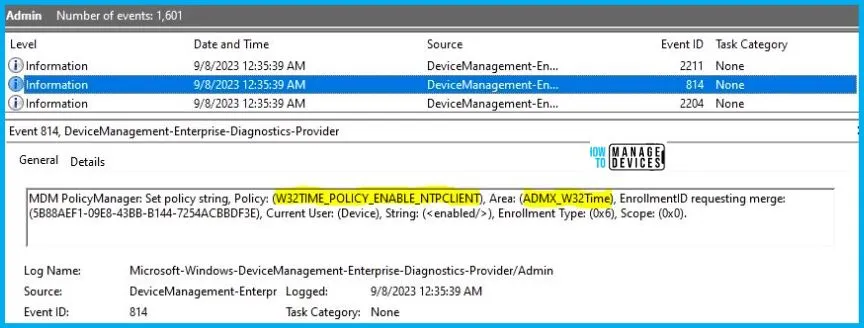
When I opened the above Event log, I found that the policy I have applied to the device has been successfully implemented. By reviewing the log entry shown in the above image, the Event Viewer, I came across essential information, including the Area and Enrollment ID. These details play a significant role in identifying the corresponding registry path. To locate the specific information, please consult the table provided below:
| Area | Policy | String | Scoped | Event ID |
|---|---|---|---|---|
| ADMX_W32Time | W32TIME_POLICY_ENABLE_NTPCLIENT | Enabled | Device | 814 |
The details presented in the table above for the Enable Windows NTP Client Policy Using Intune can be employed to access the registry settings that hold the group policy configurations on a specific computer. To accomplish this, you can execute “REGEDIT.exe” on the target computer and navigate to the precise registry path where these settings are stored.
- Computer\HKEY_LOCAL_MACHINE\SOFTWARE\Microsoft\PolicyManager\providers\5B88AEF1-09E8-43BB-B144-7254ACBBDF3E\default\Device\ADMX_W32Time
When you navigate the above path in the Registry Editor, you will find the registry key named W32TIME_POLICY_ENABLE_NTPCLIENT. Also, when I navigated to the above path, I saw that the Registry Key was created.
| Registry Name | Value |
|---|---|
| W32TIME_POLICY_ENABLE_NTPCLIENT | Enabled |

Author
Abhinav Rana is working as an SCCM Admin. He loves to help the community by sharing his knowledge. He is a B.Tech graduate in Information Technology.

